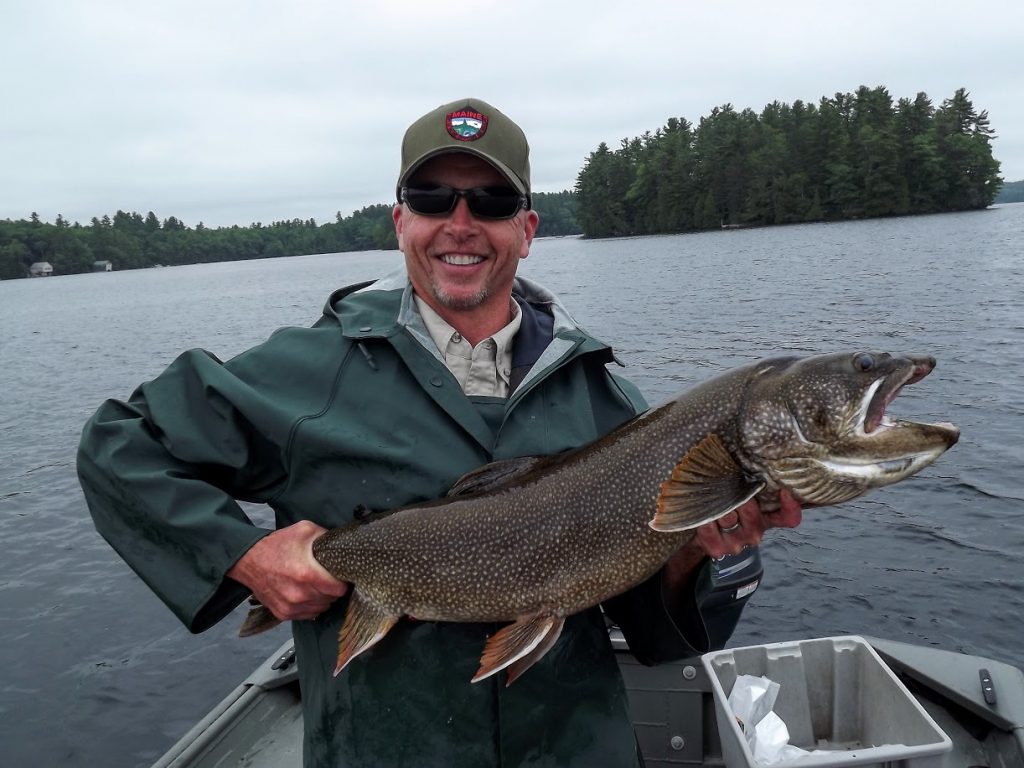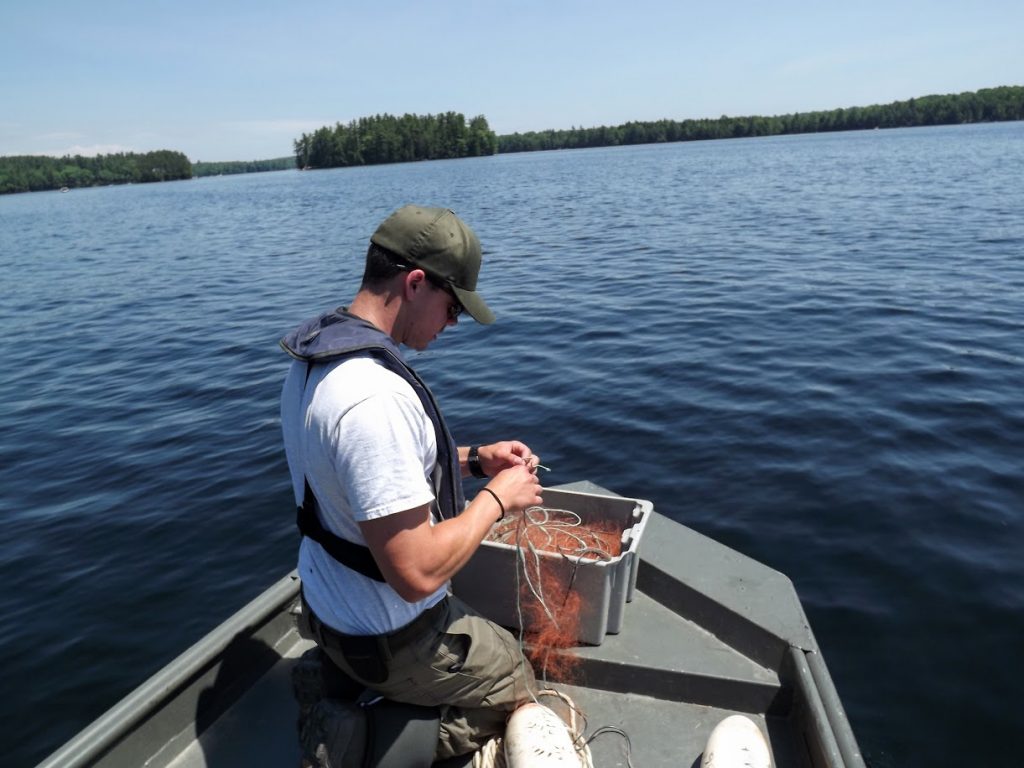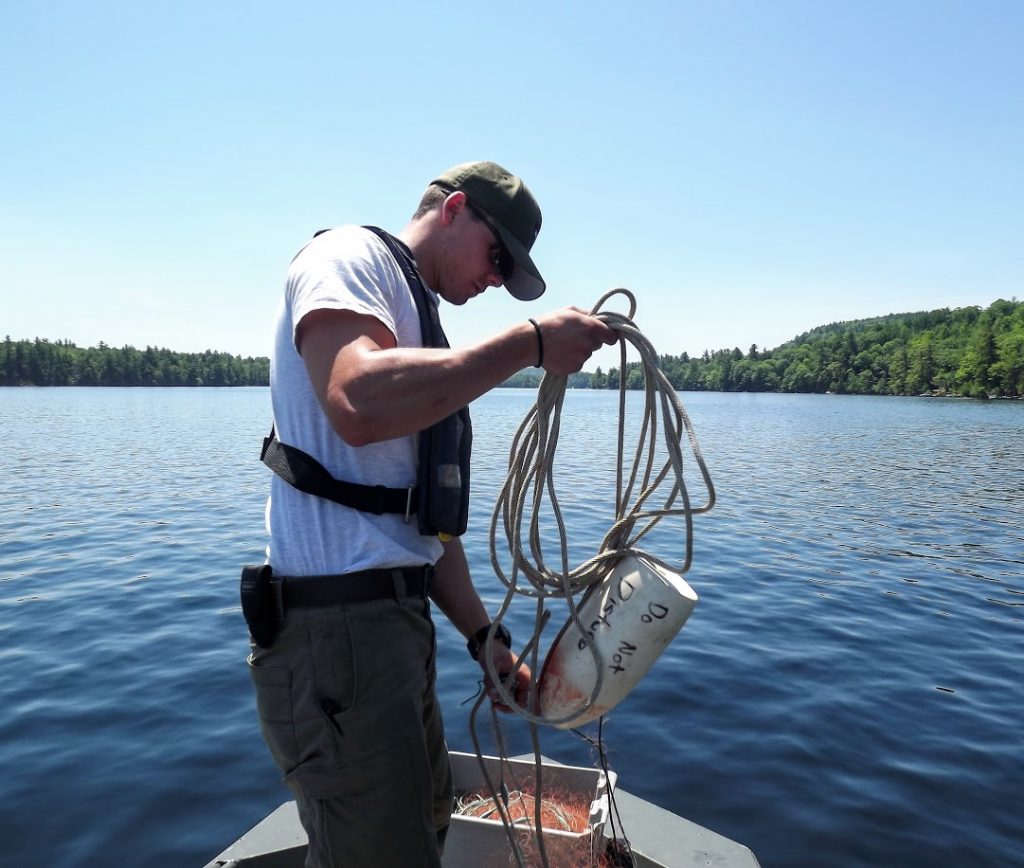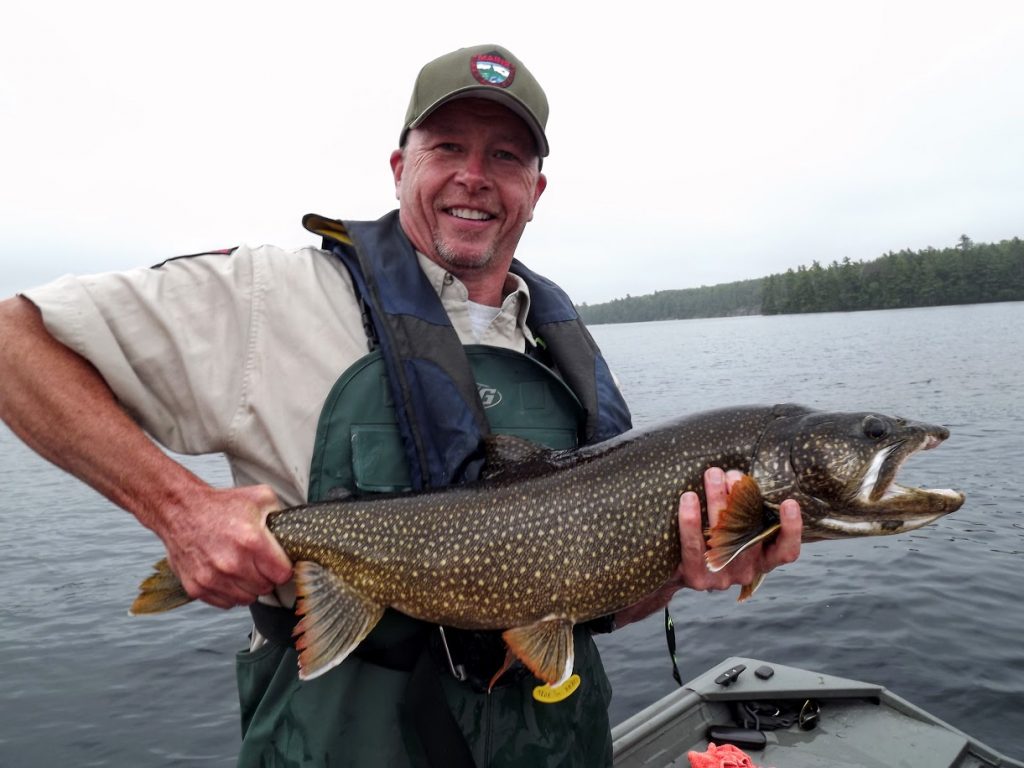July 15, 2016 at 1:44 pm
[caption id="attachment_1745" align="alignright" width="568"] IFW's Tom Barrows holds a hefty 35-inch wild togue from Echo Lake in Fayette. The togue was measured, weighed and released.[/caption]
The bios in Region B have been busy on central Maine lakes recently, keeping an eye on salmon and lake trout growth in Echo Lake. The central Maine lake occupies parts of Fayette, Mount Vernon and Readfield.
IFW fisheries biologists use nets as a tool to gather population samples on a number of lakes throughout the state. The fish gathered are measured, weighed and aged, which gives biologists insight into the health of the population.
“Right now, things are great in Echo, the smelt abundance is high, and we are seeing excellent growth rates on both salmon and togue,” said Region B fisheries biologist Jason Seiders.
Salmon growth is near exceptional, as salmon that were stocked last year at 8 to 10 inches are now 16 to 17 inches in length with very good weights. These fish are growing over six inches a year!
[caption id="attachment_1738" align="alignleft" width="471"]
IFW's Tom Barrows holds a hefty 35-inch wild togue from Echo Lake in Fayette. The togue was measured, weighed and released.[/caption]
The bios in Region B have been busy on central Maine lakes recently, keeping an eye on salmon and lake trout growth in Echo Lake. The central Maine lake occupies parts of Fayette, Mount Vernon and Readfield.
IFW fisheries biologists use nets as a tool to gather population samples on a number of lakes throughout the state. The fish gathered are measured, weighed and aged, which gives biologists insight into the health of the population.
“Right now, things are great in Echo, the smelt abundance is high, and we are seeing excellent growth rates on both salmon and togue,” said Region B fisheries biologist Jason Seiders.
Salmon growth is near exceptional, as salmon that were stocked last year at 8 to 10 inches are now 16 to 17 inches in length with very good weights. These fish are growing over six inches a year!
[caption id="attachment_1738" align="alignleft" width="471"] Camden Marshall prepares to set the net. The net remains in the water overnight, and is retrieved the next morning.[/caption]
Perhaps even more encouraging is what Seiders is seeing with the lake trout population in Echo.
“Echo is one of the few wild trout resources that we have here in central Maine,” says Seiders. “We have half a dozen of these waters in our region and we keep a close eye on them.”
Among the samples were two togue that exceeded 30 inches in length, including one that was 35”. Examination of both fish showed that they were wild fish. Both fish were released and are back in Echo Lake.
Setting the nets at the right depth is the key to getting a valid number of fish to sample. Seiders measures both the temperature and the dissolved oxygen levels at various depths to find the zone were cold water fish like salmon and togue are residing.
“We look for water temps no warmer than the 60s, and oxygen levels that are above five parts per million,” said Seiders.
In Echo that meant setting the nets in the 30-40 foot deep range. The nets are set overnight, and biologists check them the next morning. The overnight set yielded lake trout, salmon and a handful of cusk. Only one togue was a stocked fish.
[caption id="attachment_1739" align="alignright" width="487"]
Camden Marshall prepares to set the net. The net remains in the water overnight, and is retrieved the next morning.[/caption]
Perhaps even more encouraging is what Seiders is seeing with the lake trout population in Echo.
“Echo is one of the few wild trout resources that we have here in central Maine,” says Seiders. “We have half a dozen of these waters in our region and we keep a close eye on them.”
Among the samples were two togue that exceeded 30 inches in length, including one that was 35”. Examination of both fish showed that they were wild fish. Both fish were released and are back in Echo Lake.
Setting the nets at the right depth is the key to getting a valid number of fish to sample. Seiders measures both the temperature and the dissolved oxygen levels at various depths to find the zone were cold water fish like salmon and togue are residing.
“We look for water temps no warmer than the 60s, and oxygen levels that are above five parts per million,” said Seiders.
In Echo that meant setting the nets in the 30-40 foot deep range. The nets are set overnight, and biologists check them the next morning. The overnight set yielded lake trout, salmon and a handful of cusk. Only one togue was a stocked fish.
[caption id="attachment_1739" align="alignright" width="487"] Camden Marshall readies the marking buoys. Buoys are used to mark the location of the nets.[/caption]
The biological data gathered from these fish allows biologists to make informed decisions about management on the lake.
“We keep a close eye on the lake trout population so it doesn’t get out of control and impact smelt abundance,” said Seiders, who added that smelt abundance in the lake remains at a very good level.
Looking at these pictures of these two large, native, Echo Lake togue, it confirms that the coldwater fishery on Echo is doing quite well.
[caption id="attachment_1746" align="alignleft" width="770"]
Camden Marshall readies the marking buoys. Buoys are used to mark the location of the nets.[/caption]
The biological data gathered from these fish allows biologists to make informed decisions about management on the lake.
“We keep a close eye on the lake trout population so it doesn’t get out of control and impact smelt abundance,” said Seiders, who added that smelt abundance in the lake remains at a very good level.
Looking at these pictures of these two large, native, Echo Lake togue, it confirms that the coldwater fishery on Echo is doing quite well.
[caption id="attachment_1746" align="alignleft" width="770"] Tom Barrows hoists another wild togue that exceeds 30 inches. Echo Lake has a wild togue population that IFW fishieries biologists monitor. In Echo Lake, the abundance of smelt is the key to a thriving coldwater fishery. As this picture attests, both the Echo Lake togue and smelt populations are doing well.[/caption]
Tom Barrows hoists another wild togue that exceeds 30 inches. Echo Lake has a wild togue population that IFW fishieries biologists monitor. In Echo Lake, the abundance of smelt is the key to a thriving coldwater fishery. As this picture attests, both the Echo Lake togue and smelt populations are doing well.[/caption]
 IFW's Tom Barrows holds a hefty 35-inch wild togue from Echo Lake in Fayette. The togue was measured, weighed and released.[/caption]
The bios in Region B have been busy on central Maine lakes recently, keeping an eye on salmon and lake trout growth in Echo Lake. The central Maine lake occupies parts of Fayette, Mount Vernon and Readfield.
IFW fisheries biologists use nets as a tool to gather population samples on a number of lakes throughout the state. The fish gathered are measured, weighed and aged, which gives biologists insight into the health of the population.
“Right now, things are great in Echo, the smelt abundance is high, and we are seeing excellent growth rates on both salmon and togue,” said Region B fisheries biologist Jason Seiders.
Salmon growth is near exceptional, as salmon that were stocked last year at 8 to 10 inches are now 16 to 17 inches in length with very good weights. These fish are growing over six inches a year!
[caption id="attachment_1738" align="alignleft" width="471"]
IFW's Tom Barrows holds a hefty 35-inch wild togue from Echo Lake in Fayette. The togue was measured, weighed and released.[/caption]
The bios in Region B have been busy on central Maine lakes recently, keeping an eye on salmon and lake trout growth in Echo Lake. The central Maine lake occupies parts of Fayette, Mount Vernon and Readfield.
IFW fisheries biologists use nets as a tool to gather population samples on a number of lakes throughout the state. The fish gathered are measured, weighed and aged, which gives biologists insight into the health of the population.
“Right now, things are great in Echo, the smelt abundance is high, and we are seeing excellent growth rates on both salmon and togue,” said Region B fisheries biologist Jason Seiders.
Salmon growth is near exceptional, as salmon that were stocked last year at 8 to 10 inches are now 16 to 17 inches in length with very good weights. These fish are growing over six inches a year!
[caption id="attachment_1738" align="alignleft" width="471"] Camden Marshall prepares to set the net. The net remains in the water overnight, and is retrieved the next morning.[/caption]
Perhaps even more encouraging is what Seiders is seeing with the lake trout population in Echo.
“Echo is one of the few wild trout resources that we have here in central Maine,” says Seiders. “We have half a dozen of these waters in our region and we keep a close eye on them.”
Among the samples were two togue that exceeded 30 inches in length, including one that was 35”. Examination of both fish showed that they were wild fish. Both fish were released and are back in Echo Lake.
Setting the nets at the right depth is the key to getting a valid number of fish to sample. Seiders measures both the temperature and the dissolved oxygen levels at various depths to find the zone were cold water fish like salmon and togue are residing.
“We look for water temps no warmer than the 60s, and oxygen levels that are above five parts per million,” said Seiders.
In Echo that meant setting the nets in the 30-40 foot deep range. The nets are set overnight, and biologists check them the next morning. The overnight set yielded lake trout, salmon and a handful of cusk. Only one togue was a stocked fish.
[caption id="attachment_1739" align="alignright" width="487"]
Camden Marshall prepares to set the net. The net remains in the water overnight, and is retrieved the next morning.[/caption]
Perhaps even more encouraging is what Seiders is seeing with the lake trout population in Echo.
“Echo is one of the few wild trout resources that we have here in central Maine,” says Seiders. “We have half a dozen of these waters in our region and we keep a close eye on them.”
Among the samples were two togue that exceeded 30 inches in length, including one that was 35”. Examination of both fish showed that they were wild fish. Both fish were released and are back in Echo Lake.
Setting the nets at the right depth is the key to getting a valid number of fish to sample. Seiders measures both the temperature and the dissolved oxygen levels at various depths to find the zone were cold water fish like salmon and togue are residing.
“We look for water temps no warmer than the 60s, and oxygen levels that are above five parts per million,” said Seiders.
In Echo that meant setting the nets in the 30-40 foot deep range. The nets are set overnight, and biologists check them the next morning. The overnight set yielded lake trout, salmon and a handful of cusk. Only one togue was a stocked fish.
[caption id="attachment_1739" align="alignright" width="487"] Camden Marshall readies the marking buoys. Buoys are used to mark the location of the nets.[/caption]
The biological data gathered from these fish allows biologists to make informed decisions about management on the lake.
“We keep a close eye on the lake trout population so it doesn’t get out of control and impact smelt abundance,” said Seiders, who added that smelt abundance in the lake remains at a very good level.
Looking at these pictures of these two large, native, Echo Lake togue, it confirms that the coldwater fishery on Echo is doing quite well.
[caption id="attachment_1746" align="alignleft" width="770"]
Camden Marshall readies the marking buoys. Buoys are used to mark the location of the nets.[/caption]
The biological data gathered from these fish allows biologists to make informed decisions about management on the lake.
“We keep a close eye on the lake trout population so it doesn’t get out of control and impact smelt abundance,” said Seiders, who added that smelt abundance in the lake remains at a very good level.
Looking at these pictures of these two large, native, Echo Lake togue, it confirms that the coldwater fishery on Echo is doing quite well.
[caption id="attachment_1746" align="alignleft" width="770"] Tom Barrows hoists another wild togue that exceeds 30 inches. Echo Lake has a wild togue population that IFW fishieries biologists monitor. In Echo Lake, the abundance of smelt is the key to a thriving coldwater fishery. As this picture attests, both the Echo Lake togue and smelt populations are doing well.[/caption]
Tom Barrows hoists another wild togue that exceeds 30 inches. Echo Lake has a wild togue population that IFW fishieries biologists monitor. In Echo Lake, the abundance of smelt is the key to a thriving coldwater fishery. As this picture attests, both the Echo Lake togue and smelt populations are doing well.[/caption]